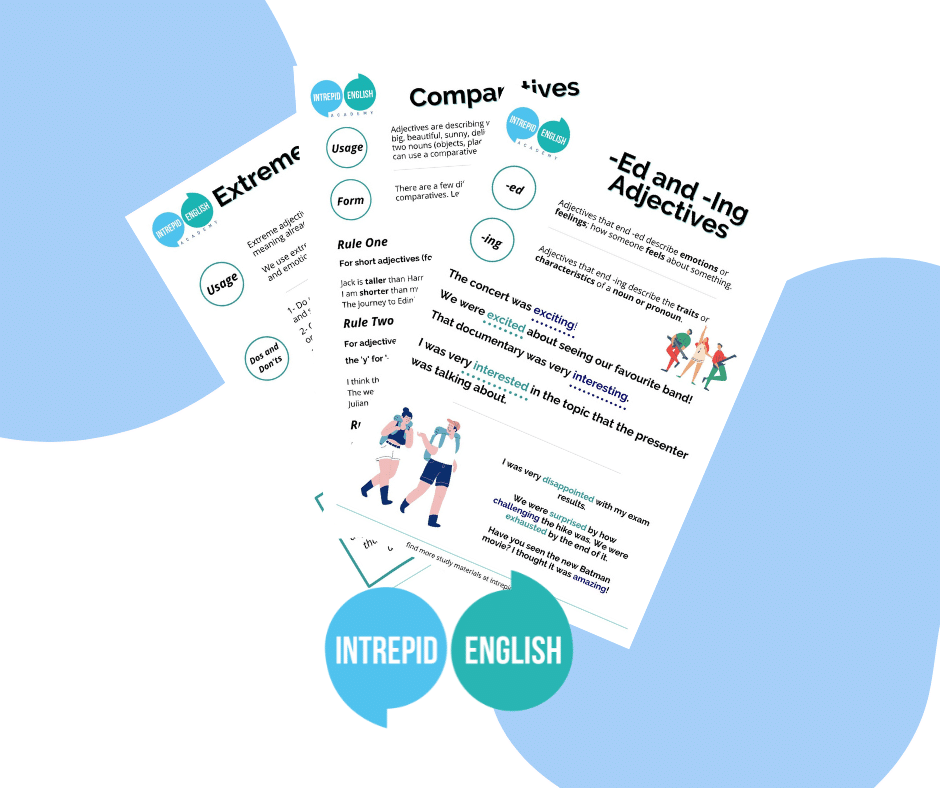Many of our students mention that they feel they struggle to express their feelings accurately in English. This can be frustrating! If you have been studying English for a while, you have probably already learnt some basic adjectives to describe your feelings when you studied the verb to be. Maybe you want to expand your vocabulary and learn some more advanced or less common adjectives to be able to talk about your feelings and be more specific or descriptive. This blog post is for you!
Extreme adjectives to talk about feelings
When someone asks you how you felt about getting the promotion, instead of saying ‘”very happy”, you can say you were “delighted!” Here are some useful extreme adjectives to describe our feelings. Check out our other blog post on extreme adjectives for more.
| Happy | Ecstatic, Overjoyed, Delighted |
| Disappointed | Devastated, Heartbroken |
| Angry | Furious, Enraged |
| Scared | Terrified, Petrified |
| Confused | Perplexed, Bewildered |
| Tired | Exhausted |
| Hungry | Famished, Starving |
| Thirsty | Parched |
Grammar: Feelings and conditionals
We can use the zero conditional to talk about how we feel in certain situations.
We use the zero conditional for general facts and truths. We use the simple present tense for both the condition and the result clause. When this thing is true, this other thing is also true. Learn more about conditional structures right here.
Follow this structure to use the zero conditional to talk about feelings:
I am/feel [adjective] when [situation in simple present].
Examples:
I feel terrified when there is turbulence.
I feel overjoyed when it rains after several days of hot weather.
I feel bewildered when I’m hanging out with a big group of people and several people are all talking at the same time!
Activity:
Practise by completing the following sentences talking about yourself.
I feel ___ when I master a new concept in English.
I feel angry when ____.
I feel ___ when I drink coffee.
I feel ecstatic when ___.
Idioms about feelings
Finally, if you want to use advanced English and really sound like a native speaker, use one of these common English idioms to express your feelings.
Over the moon
To be over the moon is another way of saying extremely happy.
“After getting the score he needed on the IELTS test, Mario was over the moon!”
Feeling blue
When you feel very sad, we can say that you are feeling blue.
“Shaun’s fiance broke up with him, so he’s been feeling blue recently.”
Down in the dumps
Similarly, if someone is down in the dumps, they are feeling very sad.
“Amy missed out on the promotion and she’s been down in the dumps. Let’s take her out for dinner tonight to cheer her up.”
Seeing red
Someone who is seeing red is very angry and may be about to lose their temper.
“Despite having much more experience and the necessary qualifications, Mario didn’t get the job because the boss decided to give it to his nephew instead. Mario was seeing red when he found out!”
Have butterflies
When you are very nervous about something, you may have butterflies in your stomach. This is a kind of nervous or anxious feeling, resulting in physical discomfort. It’s normally about something good or positive, though.
“Before stepping on stage to give the presentation, she had butterflies in her stomach, but as the crowd applauded at the end, she gave a sigh of relief and felt extremely proud of herself.”
Activity:
Practise using these idioms by writing about a time you felt over the moon, a time that you were seeing red, etc. Explain the situation and why it made you feel this way.
Want us to check your example sentences? Post them in the comments below!
Learn more about adjectives and idioms, complete practice quizzes and download worksheets in the Fast Grammar course or the Essential English Idioms course, both available in the Intrepid English Academy. Memberships start from only £49 per month.

